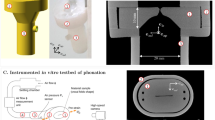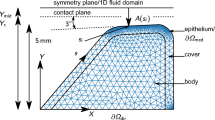Abstract
The physical mechanisms leading to the acoustic and perceptual qualities of voice are not well understood. This study examines the spatial distribution of biomechanical properties in human vocal folds and explores the consequences of these properties on phonation. Vocal fold lamina propria specimens isolated from nine excised human male larynges were tested in uniaxial tension (six from non-smokers, three from smokers). An optical method was employed to determine the local stretch, from which the elastic modulus of three segments in the anterior-posterior direction was calculated. Several specimens exhibited a significant heterogeneity in the modulus with the middle segment stiffer than the other segments. It was concluded that such modulus gradients are stronger in specimens from non-smokers than smokers. To understand the functional implications of a modulus gradient, the first eigenmode of vibration was calculated with a finite element model. With a modulus gradient, the vocal fold’s eigenmode deflection was spread along the anterior-posterior length, whereas for a homogeneous modulus distribution, the deflection was more focused around the mid-coronal plane. Consequently, the strong modulus gradient may enable more complete glottal closure, which is important for normal phonation, while a more homogeneous modulus may be responsible for poor glottal closure and a perceived “breathy” voice.





Similar content being viewed by others
Notes
Aurora Scientific Model 300B-LR, Aurora, Ontario, Canada.
Allied Vision Technologies, Stingray F-033B.
References
Auerbach, O., E. C. Hammond, and L. Garfinkel. Histologic changes in the larynx in relation to smoking habits. Cancer 25:92–104, 1970.
Awan, S. N. Automatic estimation of vocal harmonics-to-noise ratio using cepstral analysis. In: Investigations in Clinical Phonetics and Linguistics, edited by F. Windsor, M. L. Kelly, and N. Hewlett. Mahwah, NJ: Lawrence Erlbaum Associates, 2002, pp. 449–458.
Awan, S. N. The effect of smoking on the dysphonia severity index in females. Folia Phoniatr. Logop. 63:65–71, 2011.
Awan, S. N., and D. L. Morrow. Videostroboscopic characteristics of young adult female smokers vs. nonsmokers. J. Voice 21:211–223, 2007.
Baer, T., A. Löfqvist, and N. S. McGarr. Laryngeal vibrations: a comparison between high-speed filming and glottographic techniques. J. Acoust. Soc. Am. 73:1304–1308, 1983.
Bielamowicz, S., R. Kapoor, J. Schwartz, and S. V. Stager. Relationship among glottal area, static supraglottic compression, and laryngeal function studies in unilateral vocal fold paresis and paralysis. J. Voice 18:138–145, 2004.
Branski, R. C., H. Zhou, D. H. Kraus, and M. Sivasankar. The effects of cigarette smoke condensate on vocal fold transepithelial resistance and inflammatory signaling in vocal fold fibroblasts. Laryngoscope 121:601–605, 2011.
Bridger, G. P., and P. Reay-Young. Laryngeal cancer and smoking. Med. J. Austm. 2:293–294, 1976.
Castillo-Guerra, E., and A. Ruiz. Automatic modeling of acoustic perception of breathiness in pathological voices. IEEE Trans. Biomed. Eng. 56:932–940, 2009.
Cattaruzza, M. S., P. Maisonneuve, and P. Boyle. Epidemiology of laryngeal cancer. Eur. J. Cancer 32:293–305, 1996.
Centers for Disease Control and Prevention (U.S.). Vital signs: current cigarette smoking among adults aged ≥18 years—United States, 2009. MMWR Morb. Mortal Wkly. Rep. 59:1135–1140, 2010.
Chan, R. W., M. Fu, and N. Tirunagari. Elasticity of the human false vocal fold. Ann. Otol. Rhinol. Laryngol. 115:370–381, 2006.
Chan, R. W., M. Fu, L. Young, and N. Tirunagari. Relative contributions of collagen and elastin to elasticity of the vocal fold under tension. Ann. Biomed. Eng. 35:1471–1483, 2007.
Chan, R. W., T. Siegmund, and K. Zhang. Biomechanics of fundamental frequency regulation: constitutive modeling of the vocal fold lamina propria. Logop. Phoniatr. Voco. 34:181–189, 2009.
Chan, R. W., and N. Tayama. Biomechanical effects of hydration in vocal fold tissues. Otolaryngol. Head Neck Surg. 126:528–537, 2002.
Cooper, D. S., and I. R. Titze. Generation and dissipation of heat in vocal fold tissue. J. Speech Hear. Res. 28:207–215, 1985.
Damborenea Tajada, J., R. Fernández Liesa, E. Llorente Arenas, M. J. Naya Gálvez, P. Rueda Gormedino, C. Marín Garrido, and A. Ortiz García. The effect of tobacco consumption on acoustic voice analysis (Spanish). Acta Otorrinolaringol. Esp. 50:448–452, 1999.
Döllinger, M., D. A. Berry, B. Hüttner, and C. Bohr. Assessment of local vocal fold deformation characteristics in an in vitro static tensile test. J. Acoust. Soc. Am. 130:977–985, 2011.
Failla, M., A. Grappiolo, S. Carugo, I. Calchera, C. Giannattasio, and G. Mancia. Effects of cigarette smoking on carotid and radial artery distensibility. J. Hypertens. 15:1659–1664, 1997.
Fielding, J. E. Smoking: health effects and control. N. Engl. J. Med. 313:491–498, 1985.
Figueiredo, D. C., P. R. F. Souza, M. I. R. Gonçalves, and N. G. Biase. Auditory perceptual, acoustic, computerized and laryngological analysis of young smokers’ and non-smokers’ voice. Rev. Bras. Otorrinolaringol. 69:791–799, 2003.
Gonzalez, J., and A. Carpi. Early effects of smoking on the voice: a multidimensional study. Med. Sci. Monit. 10:649–656, 2004.
Goodyer, E., M. Gunderson, and S. H. Dailey. Gradation of stiffness of the mucosa inferior to the vocal fold. J. Voice 24:359–362, 2010.
Gordon, M., and P. Ladefoged. Phonation types: a cross-linguistic overview. J. Phonetics 29:383–406, 2001.
Gorham-Rowan, M. M., and J. Laures-Gore. Acoustic-perceptual correlates of voice quality in elderly men and women. J. Commun. Disord. 39:171–184, 2006.
Gray, S. D., I. R. Titze, F. Alipour, and T. H. Hammond. Biomechanical and histological observations of vocal fold fibrous proteins. Ann. Otol. Rhinol. Laryngol. 109:77–85, 2000.
Guo, X., M. J. Oldham, M. T. Kleinman, R. F. Phalen, and G. S. Kassab. Effect of cigarette smoking on nitric oxide, structural, and mechanical properties of mouse arteries. Am. J. Physiol. Heart Circ. Physiol. 291:H2354–H2361, 2006.
Haji, T., K. Mori, K. Omori, and N. Isshiki. Mechanical properties of the vocal fold Stress-strain studies. Acta Otolaryngol. (Stockh.) 112:559–565, 1992.
Hammond, T. H., S. D. Gray, and J. E. Butler. Age- and gender-related collagen distribution in human vocal folds. Ann. Otol. Rhinol. Laryngol. 109:913–920, 2000.
Hemler, R. J. B., G. H. Wieneke, J. Lebacq, and P. H. Dejonckere. Laryngeal mucosa elasticity and viscosity in high and low relative air humidity. Eur. Arch. Otorhinolaryngol. 258:125–129, 2001.
Hertegård, S., and J. Gauffin. Glottal area and vibratory patterns studied with simultaneous stroboscopy, flow glottography, and electroglottography. J. Speech Hear. Res. 38:85–100, 1995.
Hess, M. M., F. Muller, J. B. Kobler, S. M. Zeitels, and E. N. Goodyer. Measurements of vocal fold elasticity using the linear skin rheometer. Folia Phoniatr. Logop. 58:207–216, 2006.
Hirabayashi, H., K. Koshii, K. Uno, H. Ohgaki, Y. Nakasone, T. Fujisawa, N. Shono, T. Hinohara, and K. Hirabayashi. Laryngeal epithelial changes on effects of smoking and drinking. Auris Nasus Larynx 17:105–114, 1990.
Honjo, I., and N. Isshiki. Laryngoscopic and voice characteristics of aged persons. Arch. Otolaryngol. 106:149–150, 1980.
Hoppe, U., F. Rosanowski, M. Döllinger, J. Lohscheller, M. Schuster, and U. Eysholdt. Glissando: laryngeal motorics and acoustics. J. Voice 17:370–376, 2003.
Kelleher, J. E., T. Siegmund, R. W. Chan, and E. A. Henslee. Optical measurements of vocal fold tensile properties: implications for phonatory mechanics. J. Biomech. 44:1729–1734, 2011.
Kelleher, J. E., K. Zhang, T. Siegmund, and R. W. Chan. Spatially varying properties of the vocal ligament contribute to its eigenfrequency response. J. Mech. Behav. Biomed. Mater. 3:600–609, 2010.
Lee, L., J. C. Stemple, D. Geiger, and R. Goldwasser. Effects of environmental tobacco smoke on objective measures of voice production. Laryngoscope 109:1531–1534, 1999.
Linville, S. E. Source characteristics of aged voice assessed from long-term average spectra. J. Voice 16:472–479, 2002.
Lohscheller, J., U. Eysholdt, H. Toy, and M. Döllinger. Phonovibrography: mapping high-speed movies of vocal fold vibrations into 2-D diagrams for visualizing and analyzing the underlying laryngeal dynamics. IEEE Trans. Med. Imaging 27:300–309, 2008.
Marcotullio, D., G. Magliulo, and T. Pezone. Reinke’s edema and risk factors: clinical and histopathologic aspects. Am. J. Otolaryngol. 23:81–84, 2002.
Mehta, D. D., and R. E. Hillman. Voice assessment: updates on perceptual, acoustic, aerodynamic, and endoscopic imaging methods. Curr. Opin. Otolaryngo. 16:211–215, 2008.
Miri, A. K., F. Barthelat, and L. Mongeau. Effects of dehydration on the viscoelastic properties of vocal folds in large deformations. J. Voice, 2012. http://dx.doi.org/10.1016/j.jvoice.2011.09.003.
Mori, K., S. M. Blaugrund, and J. D. Yu. The turbulent noise ratio: an estimation of noise power of the breathy voice using PARCOR analysis. Laryngoscope 104:153–158, 1994.
Müller, K.-M., and B. R. Krohn. Smoking habits and their relationship to precancerous lesions of the larynx. J. Cancer Res. Clin. Oncol. 96:211–217, 1980.
Saraf, H., K. T. Ramesh, A. M. Lennon, A. C. Merkle, and J. C. Roberts. Mechanical properties of soft human tissue under dynamic loading. J. Biomech. 40:1960–1967, 2007.
Schuberth, S., U. Hoppe, M. Döllinger, J. Lohscheller, and U. Eysholdt. High-precision measurement of the vocal fold length and vibratory amplitudes. Laryngoscope 112:1043–1049, 2002.
Sivasankar, M., and C. Leydon. The role of hydration in vocal fold physiology. Curr. Opin. Otolaryngol. Head Neck Surg. 18:171–175, 2010.
Sorensen, D., and Y. Horii. Cigarette smoking and voice fundamental frequency. J. Commun. Disord. 15:135–144, 1982.
Švec, J., and H. Schutte. Videokymography: high-speed line scanning of vocal fold vibration. J. Voice 10:201–205, 1996.
Titze, I. R. Parameterization of the glottal area, glottal flow, and vocal fold contact area. J. Acoust. Soc. Am. 75:570–580, 1984.
Titze, I. R. The physics of small-amplitude oscillation of the vocal folds. J. Acoust. Soc. Am. 83:1536–1552, 1988.
Titze, I. R. Mechanical stress in phonation. J. Voice 8:99–105, 1994.
Titze, I. R. Principles of Voice Production, 2nd ed. Denver: National Center for Voice and Speech, 320 pp, 2000.
Titze, I. R. The Myoelastic Aerodynamic Theory of Phonation. Iowa City: National Center for Voice and Speech, 240 pp, 2006.
van den Berg, J. Myoelastic-aerodynamic theory of voice production. J. Speech Hear. Res. 1:227–244, 1958.
Zhang, K., T. Siegmund, and R. W. Chan. A constitutive model of the human vocal fold cover for fundamental frequency regulation. J. Acoust. Soc. Am. 119:1050–1062, 2006.
Acknowledgments
The authors are grateful to the National Institutes of Health (NIDCD Grant R01 DC006101) for funding this investigation. J.E. Kelleher is thankful to the National Science Foundation for support a graduate research fellowship. We would also like to thank Erin Henslee, Mindy Du, and Elhum Naseri for their skillful assistance in the experimental measurements.
Conflict of interest
No conflict of interest exists which would have inappropriately influenced this work.
Author information
Authors and Affiliations
Corresponding author
Additional information
Associate Editor Eiji Tanaka oversaw the review of this article.
Rights and permissions
About this article
Cite this article
Kelleher, J.E., Siegmund, T. & Chan, R.W. Could Spatial Heterogeneity in Human Vocal Fold Elastic Properties Improve the Quality of Phonation?. Ann Biomed Eng 40, 2708–2718 (2012). https://doi.org/10.1007/s10439-012-0609-1
Received:
Accepted:
Published:
Issue Date:
DOI: https://doi.org/10.1007/s10439-012-0609-1




